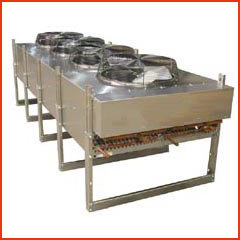Air Cooled Heat Exchangers
Jump to navigation
Jump to search
An air-cooled heat exchanger (ACHE) is used to cool fluids with ambient air and also we can simply say that a pressure vessel which cools a circulating fluid within finned tubes by forcing ambient air over the exterior of the tubes. The basic components are one or more tube sections served by one or more axial flow fans, fan drivers, speed reducers, and an en-closing and supporting structure. Air-cooled heat exchangers are classed as forced draft when the tube section is located on the discharge side of the fan, and as induced draft when the tube section is located on the suctionside of the fan.
Air cooled heat exchangers are used for two primary reasons:
♣ They increase plant efficiency
♣ They are a "green" solution as compared to cooling towers and shell and tube heat exchangers because they do
not require an auxiliary water supply (water lost due to drift and evaporation, plus no water treatment chemicals
are required).
 Air-cooled heat exchangers are generally used where a process system generates heat which must be removed, but for which there is no local use. A good example is the radiator in your car. The engine components must be cooled to keep them from overheating due to friction and the combustion process. The excess heat is carried away by the water/glycol coolant mixture. A small amount of the excess heat may be used by the car's radiator to heat the interior. Most of the heat must be dissipated somehow. One of the simplest ways is to use the ambient air. Air-cooled heat exchangers (often simply called air-coolers) do not require any cooling water from a cooling tower. They are usually used when the outlet temperature is more than about 20 deg. F above the maximum expected ambient air temperature. They can be used with closer approach temperatures, but often become expensive compared to a combination of a cooling tower and a water-cooled exchanger.
Air-cooled heat exchangers are generally used where a process system generates heat which must be removed, but for which there is no local use. A good example is the radiator in your car. The engine components must be cooled to keep them from overheating due to friction and the combustion process. The excess heat is carried away by the water/glycol coolant mixture. A small amount of the excess heat may be used by the car's radiator to heat the interior. Most of the heat must be dissipated somehow. One of the simplest ways is to use the ambient air. Air-cooled heat exchangers (often simply called air-coolers) do not require any cooling water from a cooling tower. They are usually used when the outlet temperature is more than about 20 deg. F above the maximum expected ambient air temperature. They can be used with closer approach temperatures, but often become expensive compared to a combination of a cooling tower and a water-cooled exchanger.